This article is by Sarah Emmott and Holly Chen. Holly runs ExponentialX, a marketing and growth collective that advises SaaS companies like Miro, Loom, and ServiceNow. She was previously Global Head of Digital Marketing at Slack, Head of Growth at Google Store, Head of Google B2B Websites, and guest lectures at Berkeley and NYU on advertising and marketing strategy. Sarah is Atlassian’s Global Head of Brand for the work management portfolio, previously at Square, and went in-house after years at agencies doing award-winning creative, content and campaigns. She advises on brand and marketing for SaaS, FinTech and HealthTech companies and regularly speaks in podcasts about marketing.
On the heels of a surge in earnings earlier this year, Airbnb gave credit to a surprising superhero — their shift in spend from performance marketing to brand marketing. This is a rare statement in tech companies – which most often credit product-led growth and spend the bulk of their marketing dollars on the quick and measurable returns of performance marketing to help fuel the pipeline.
So let’s dig into it. Beyond the very basic brand identity needs — a name, logo, and core brand message — startups used to leave splashy campaigns to when they are in a later stage. Instead, until they’re a BigCo, many startups stick to performance marketing (like digital ads and affiliate marketing) to get customers into the product funnel.
But if billboards off the 101 freeway in the Bay Area are any indicator, Airbnb is far from an outlier here. Looking out your car window, you’ll see a wide variety of company stages: early-stage startups like Equals and Writer; growth stages like Vanta and Notion; later-stage Intercom and Brex and public companies like Salesforce and Atlassian. Even Slack, one of the whales of the PLG wave, launched a series of TV commercials just two years after the product’s public launch.
Industry incumbents like Salesforce and Atlassian’s Jira are defending their turf. Writer and Equals are newer entrants and Notion and Brex are gaining market share in increasingly crowded spaces – thus using brand as a differentiated stake in the ground. Airbnb sits in the middle – with their growth engine slowing they turned to brand marketing using standout creative (see ‘Cluck Ya’ to advertise their farm category – still a favorite) for longtail returns.
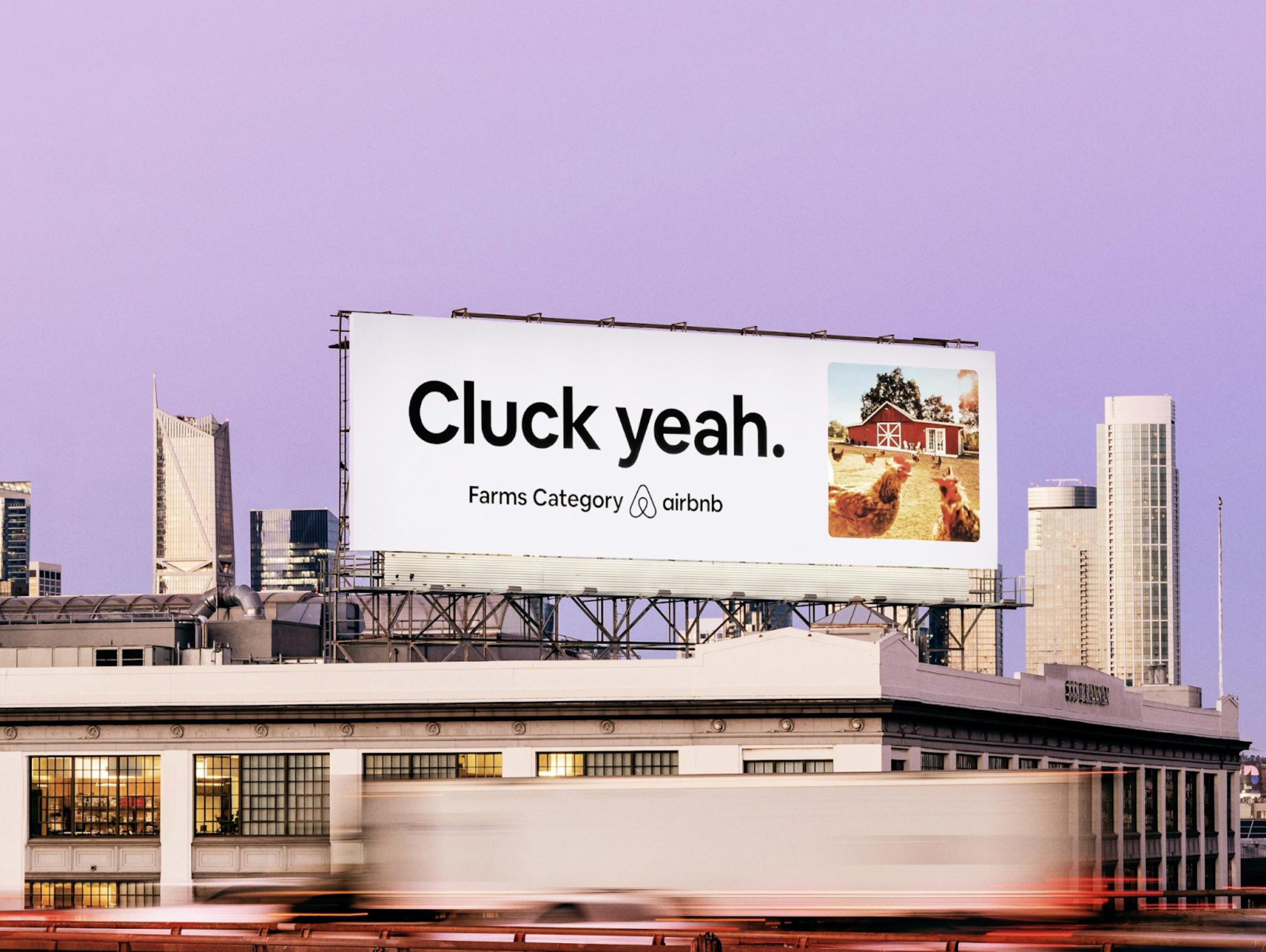
It may not seem like the right time to dive into performance marketing. In 2023 we’re seeing companies reducing budget and headcount in a tightened economy. Sustainable revenue growth and efficiency rules the day and spray-and-pray has no place in a more cash-conscious environment. And investing in brand advertising too early may be a costly decision: Quibi in 2020 launched with much fanfare with pricey ad spots during the Super Bowl and Oscars and working with high-profile celebrities. Although backed by $1.75B in funding, Quibi’s brand advertising couldn’t replace product-market fit and the company shut down just six months after launch.
But it’s not that simple to shut off this growth lever entirely. Monday.com is a prime example where performance marketing played a critical role in driving initial success with its massive YouTube ad campaigns in its early days. In 2022, when most companies cut performance marketing budgets, Monday increased it. It’s a gamble that paid off — Monday was able to use effective performance marketing to scale annual revenue from $10M to $500M in five years.
Having seen positive and negative examples on both sides, how can companies know when and how to invest in brand or performance marketing? What factors can you take into consideration for your own startup? What are the pitfalls to avoid? With annual planning season in full swing, we’ll unpack the different factors and rubric for evaluating your performance versus brand marketing budget allocation, to build your most effective marketing strategy for the upcoming year.
This guide is for you if you’re a founder or part of the leadership team at a company that’s found product-market fit, and you want more precise guidance on creating your brand and performance marketing strategy. We’ll cover the key differences between brand and performance marketing, when you might consider investing in each, as well as some of the common spending patterns we’ve seen over the course of working with dozens of startups. We’ll also explain how to measure success for brand and performance. Along the way, we’ll include plenty of recognizable examples from Airbnb, Slack, Stripe and more to put these ideas into practice. Let’s get started.
BRAND VS. PERFORMANCE: UNDERSTANDING THE CRITICAL DIFFERENCES
Before diving in, let’s first define what we mean by Brand and Performance. In this guide, we have primarily honed in on the 'Advertising' portion of 'Brand and Performance,' rather than the broader definition of 'Brand Marketing and Performance Marketing,' mainly because advertising is often the biggest line item on your marketing budget.
But first, a quick caveat here: It's not about one being better than the other but recognizing when and how to use them effectively.
Unpacking the Ins and Outs of Brand
The concept of a Brand is multifaceted and extends beyond mere aesthetics or a logo. A brand encapsulates everything that a company or product stands for; it's the customer’s entire perception. Take, for example, Apple. Its reputation as a strong brand isn't solely about the products themselves but the emotions, values, and experiences that they evoke.
Brand Marketing is a comprehensive approach focused on building awareness, identity and positioning. It may include a mix of campaigns, creative, public & analyst relations, social media and content marketing. These functions help to shape the perception and understanding of what the brand represents.
Then there's Brand Advertising, one of the essential tools in brand building. Brand advertising uses paid media to drive brand awareness and education. The channels employed can be traditional ones like TV, audio, print and out-of-home advertising like billboards and bus station wraps, and it can also include digital channels such as streaming audio (like Spotify, iHeartRadio, and podcasts), connected TV (Hulu, Roku), social video, programmatic display ads and more if their goals are driving brand awareness. These mediums serve to etch the brand into the public consciousness.
Simply put: brand aims to build awareness, affinity, and perception — fostering consideration and education about a product or service.
And that is exactly what Airbnb did – by using brand marketing to educate their audience rather than focusing on “buying customers.”

If you like Holly Chen's advice, consider taking her Build your Startup Growth Machine course on Maven
The Performance Perspective
In a broader definition, Performance Marketing is all about driving user conversion, whether it's a purchase, a sign-up, or a demo request. This could include tactics like SEO, CRO (conversion rate optimization), affiliate marketing, direct mail, digital ads and more.
In a narrower definition, Performance Marketing is often used to refer to Performance Advertising, or Direct Response Advertising, specifically to advertising aimed at driving user actions. Typically, this includes channels like digital advertising on search ads, display ads, paid social ads, etc. These targeted strategies ensure that marketing budgets are spent on creating direct, tangible results in terms of user growth.
Performance advertising is laser-focused on conversion. The primary goal is to drive a customer to purchase, sign up for an account, or talk to sales. It's about action and response.
BETTER TOGETHER: THE SYMBIOTIC RELATIONSHIP BETWEEN BRAND AND PERFORMANCE
Brand and performance marketing are not opposite sides of extremes. While they have important distinctions, brand and performance marketing are best utilized in harmony to achieve 1+1>2: their combined impact is greater than the sum of their individual effects.
From a consumer standpoint, every interaction and every touchpoint is a brand experience. In parallel, from a company's perspective, every advertising dollar invested must perform.
While it’s tricky to track a direct attributable click from brand advertising, the stimuli often nudge potential customers to type the company name into search. The ripple effect? A tangible uptick in direct and organic brand search traffic and a spike in website conversion rates, courtesy of the brand trust that’s been cultivated.
Take, for instance, when Duolingo launched its whimsical brand campaign featuring its quirky owl mascot, the product’s performance ads experienced a significant uptick in user engagement. The brand became synonymous with fun language learning, and app downloads soared.
Meanwhile, performance ads can also enhance brand equity by delving deeper, offering a comprehensive view of a product's features and inherent value. Slack, for example, followed up its brand promise and brand ad campaign of “Where Work Happens” with performance ads showcasing specific features, integrations, and user testimonials, thus painting a more comprehensive picture.
WHERE BRAND AND PERFORMANCE EXCEL (AND WHERE THEY FALL SHORT)
Understanding the distinctions between brand and performance is essential for any marketing strategy. It's not about one being better than the other but recognizing when and how to use them effectively. A balanced combination of both brand and performance advertising can create a powerful marketing strategy that not only supercharges brand loyalty but drives immediate conversion.
Here are a few of the differences between the two approaches:
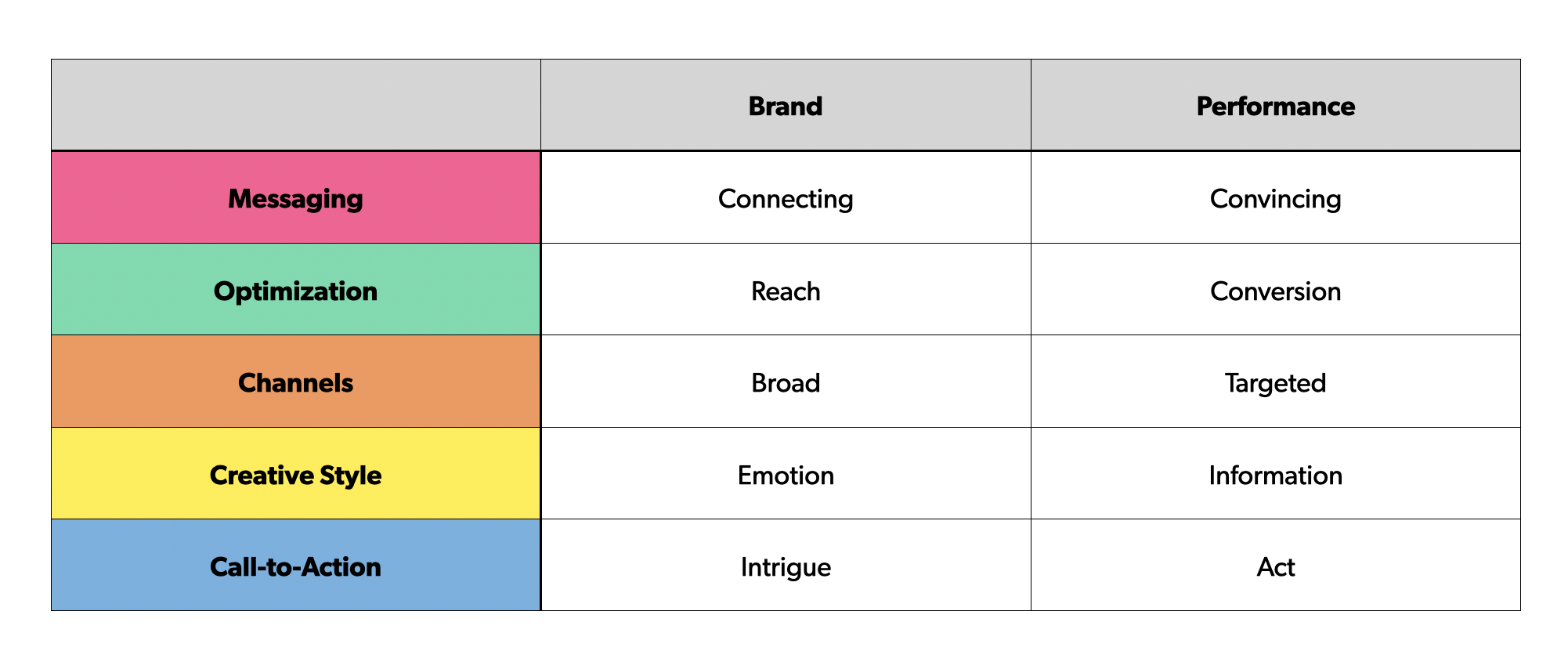
- Messaging: Connecting vs. Convincing. In terms of messaging, brand advertising typically zeroes in on building an emotional connection, trust, and intrigue. Think iconic campaigns like Nike's "Just Do It" or Airbnb’s “Belong Anywhere.” Performance advertising takes a different tack, emphasizing value and utility. It's about presenting the tangible benefits of a product or service. An example is the description of Trello that highlights specific features and appeals directly to the customer's needs and wants: “Trello’s boards, lists and cards let you get more projects done in a fun, collaborative way.”
- Optimization Goals: Reach vs. Conversion. In terms of setting campaign goals and KPIs, brand advertising focuses on driving more reach (impressions and views), while performance advertising concentrates on conversions (purchases, sign-ups, demo requests, or clicks).
- Channels and Placements: Broad vs. Targeted. Brand advertising often leverages broad channels such as TV, audio, print, OOH, and premium digital outlets (like “The New York Times” and “Vanity Fair”). Placement at the top of the homepage is commonplace. Performance advertising, conversely, is keen on targeted digital ads like search ads and display placements that can be bought programmatically (e.g., the right-side column of an article on USAtoday.com). Platforms like Google and Meta are dominant players here.
- Creative Styles: Emotion vs. Information. Creatively, brand ads often lead with a striking image that evokes emotions, storytelling-style videos that feature people, and simple and memorable one-liners. Performance ads are more likely to lead with feature benefits, showcasing product images or specific assets like an eBook cover.
- Call-to-Action: Intrigue vs. Act. Brand advertising typically doesn’t have a call-to-action. Performance advertising, on the other hand, urges immediate action with prompts like 'Buy now,' 'Sign up for free,' or 'Request a demo.'
To put these ideas into practice, take these two ad examples from Square:

Square’s Forged in Flint from their “For Every Dream” film series are brand ads showcasing the emotional and inspirational stories of small business owners with no direct product value props.
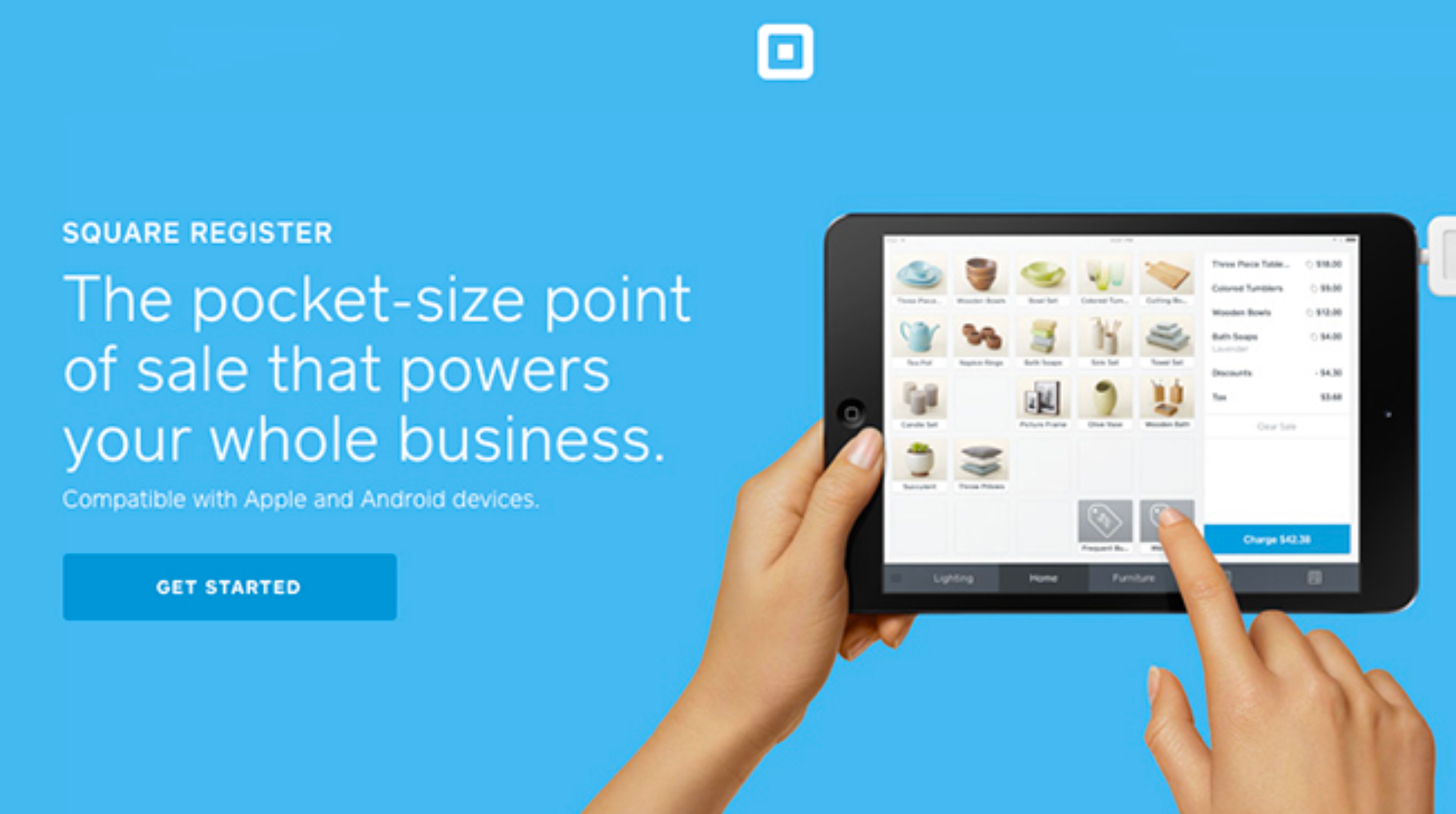
Meanwhile, Square’s Register performance ad puts the product value prop front-and-center using messaging and imagery optimized for viewers to consider or immediately try the product.
WHEN TO INVEST IN BRAND OR PERFORMANCE (OR BOTH)?
Deciding when to invest in brand or performance media is a delicate dance depending on everything from the product itself to the market and the specificities of the company.
Here’s our framework to examine these critical dimensions:
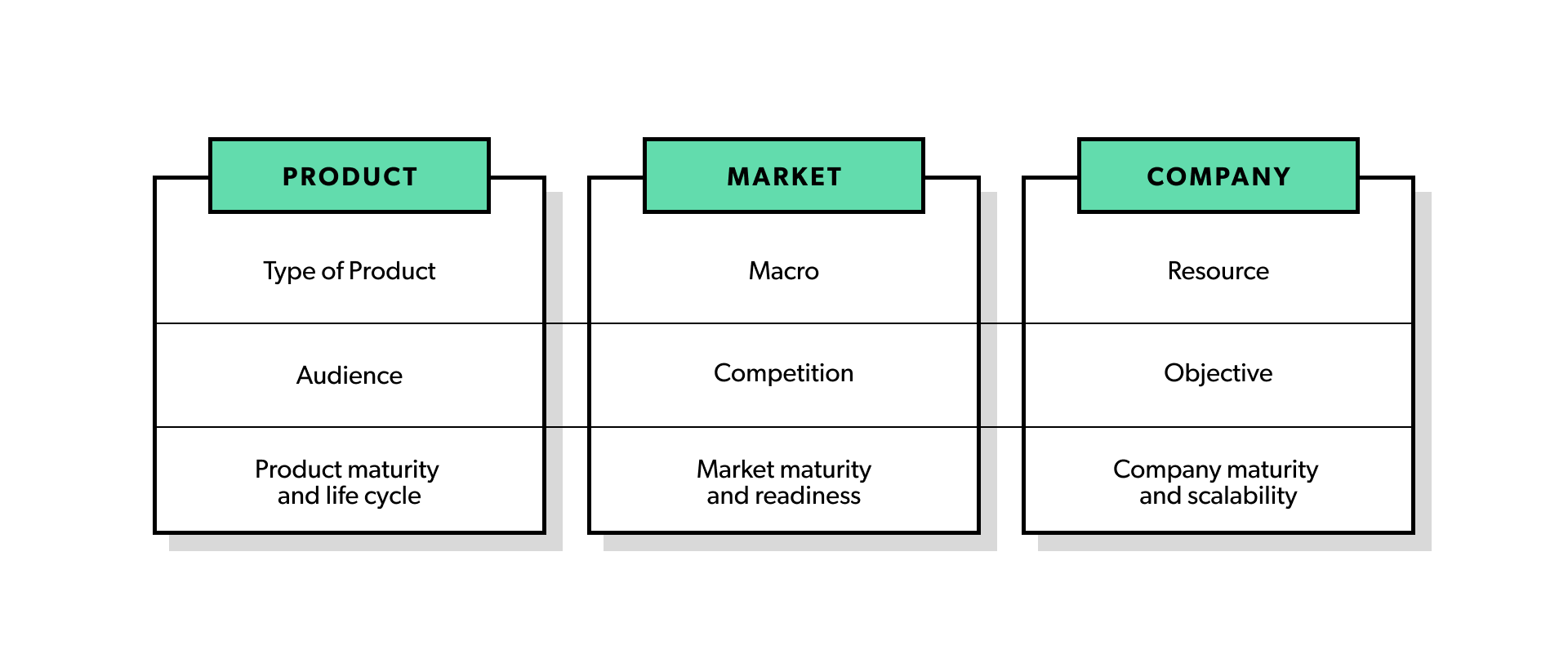
1. Product Considerations
Type of Product: The nature of the product profoundly shapes the marketing approach.
- High-ticket items and high-touch products, such as luxury goods like Gucci or complex B2B solutions like Salesforce, usually require heavy investment in brand marketing to create affinity and establish credibility.
- Conversely, products with lower barriers of entry or lower cost, such as mobile game apps, tend to leverage performance marketing from the get-go to kickstart user acquisition. And once a certain scale is achieved, like ranking on the top charts in the App Store, organic traffic catches up.
Audience: The approach shifts according to the breadth and nature of the audience.
- Broad consumer brands often need expansive brand advertising, whereas B2B brands might prioritize targeted demand-generation efforts.
- More and more PLG or horizontal SaaS companies with a wider audience invest in brand advertising after a certain scale. Zoom’s "Meet Happy" campaign, for instance, was widespread across digital platforms, television, and outdoor billboards. Sales-led SaaS companies or vertical SaaS companies tend to focus more on targeted brand channels such as conferences, podcasts, industry PR and highly targeted brand ads at key locations where target accounts are concentrated.
Product Maturity and Lifecycle:
- A focus on brand equity should be established from day one, while brand advertising typically comes in after growth funding in Series C.
- Performance advertising can start small and be employed to test, scale and defend the brand through various stages of the product's lifecycle.
2. Market Considerations
Macro Factors:
During a strong economy, consumers might be more willing to try new things, necessitating a balanced approach. But economic downturns might require a performance-driven and scrappier approach to demonstrate tangible value. Or – even a pause in all ad spend – to preserve cash and extend runway in an uncertain funding environment.
In fact, it might seem like one of the easiest line items to cut in the budget. But think twice before picking up the red pen — when everyone is pulling back spend in a down economy, the cost for performance marketing is at its lowest. (We’ll cover more common spend patterns in the following section.)
Competition:
Highly competitive markets demand a blended approach of brand and performance advertising to ensure differentiation and discovery. DTC mattress brands, for example, like Purple and Casper both had to invest heavily in both brand and performance ads.
Early-stage startups should consider finding less competitive channels within a crowded market. For example, in a saturated world of fitness apps, a new entrant might sidestep the crowded social media ad space and instead leverage niche newsletters or podcasters to penetrate specific or overlooked market segments.
Market Maturity and Readiness:
Brand marketing is vital to educate the market for startups pioneering new concepts or creating a new category. When Slack first launched, it was a new concept — people were not searching for “a digital workspace that consolidates team communication and collaboration.” To educate the market, Slack leaned into PR and a high-impact TV campaign to create a brand story that stood for a new way of working. Once they established their brand, performance marketing was then layered on to drive adoption.
3. Company Considerations
Resource Allocation: All startups face some sort of constraints in time, money, and personnel (probably all three).
Performance marketing can be more accessible at the start, while brand advertising requires a significant commitment and often demands more iterations around creatives — it’s harder to replace a billboard than a Facebook ad.
Other parts of the business, such as product development, operations and compliance, may demand more attention and prioritization.
Objectives:
Beyond growth, other strategic objectives like pre-IPO buzz, capitalizing on market trends like the AI boom, or reversing a PR crisis (think Facebook’s data privacy campaign), might necessitate investment in brand advertising on top of performance advertising.
In the case of Airbnb, the recent brand ad investment focused on new product offerings and host education, while earlier performance ads were oriented towards getting the core offering discovered when brand awareness was low to gain market share.
Company Maturity and Scalability: As startups grow, the balance between brand and performance marketing may shift.
Performance marketing often scales more easily, so it’s commonly used at earlier-stage startups, and brand ads require more resources and are more often used at mature companies.
For Airbnb, when brand awareness reached a certain saturation, another $1M performance advertising may not drive a notable lift, while brand advertising serves as a refresher and reminder.
Putting it all together for the business
Now, let’s put both brand and performance ads in a broader marketing strategy context across four phases:
- Initiation: Focus on building your brand identity, voice and messaging — don’t spend on brand or performance ads yet.
- Pre-PMF: Focus on organic growth channels such as SEO content marketing for performance, with minimal performance ads for market testing. For brand marketing, lean on your community, Execs, PR, micro-influencers, brand partners and product evangelists.
- Post-PMF: Accelerate acquisition by scaling SEO and performance ads, increasing focus on CRO for web, and diversifying growth channels into partnerships, affiliates, etc. On the brand front, expand efforts in events, community, customer advocacy, press, etc.
- Mature Stage: Keep up ongoing performance ads, and potentially shifting more heavily to brand ads, focusing on education and new product launches.
UNRAVELING SPEND PATTERNS:
So now that you’ve decided to invest, we want to dive deeper into the spend patterns, especially in the context of the product, company, and market’s maturity and stages. Understanding these patterns is not just vital, it's an art that can significantly impact brand and performance outcomes. Leveraging our experience working with companies at all stages, we have observed some typical spend-level patterns that shed light on strategies that succeed and the pitfalls to avoid.
Brand Ad Spend Patterns
Pattern 1: Seasonal Spikes
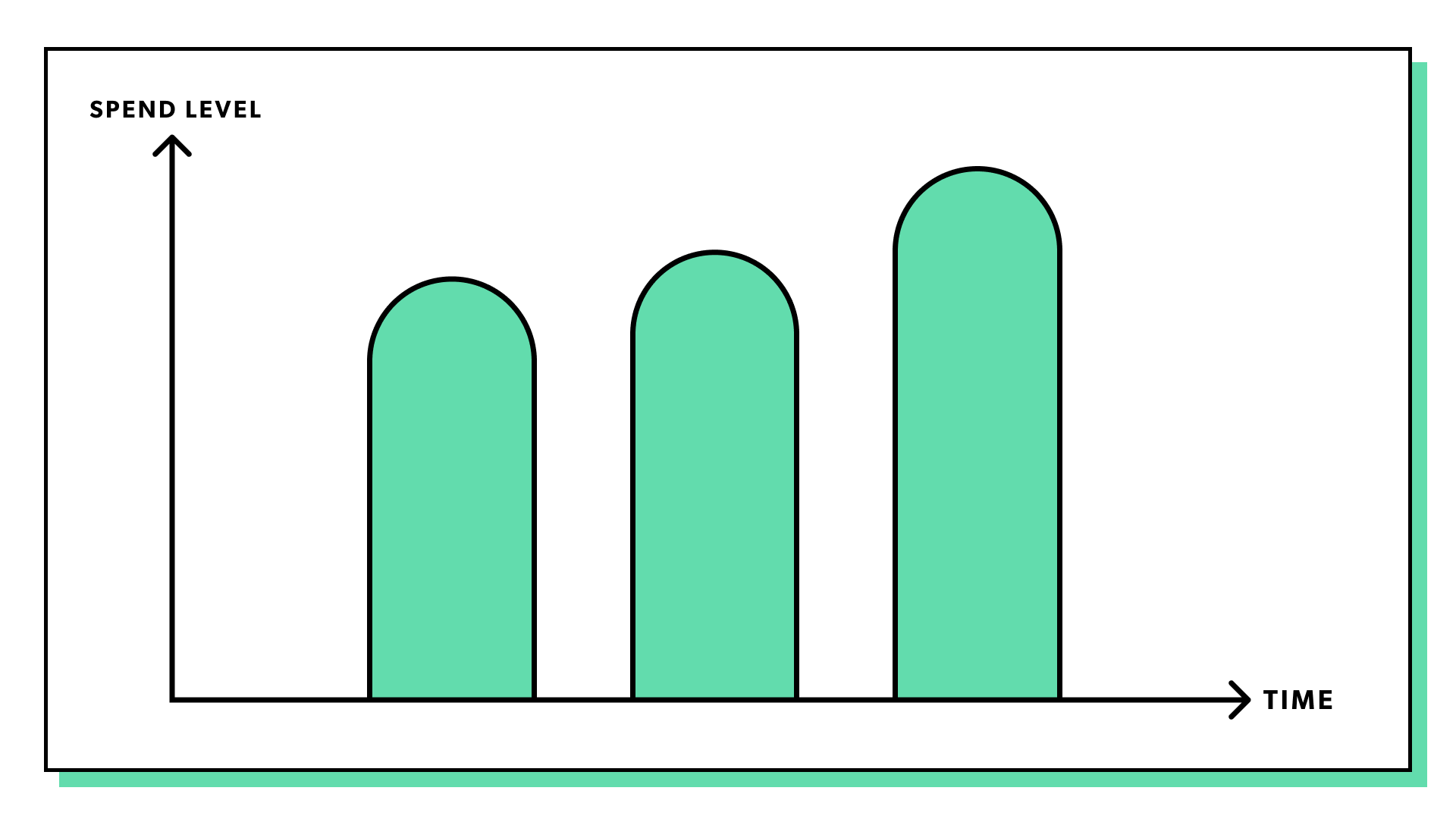
Seasonal planning is a common strategy within many companies. The brand ad spend often aligns with the product lifecycle and market dynamics. For example, A B2B company would increase their spending in Q3 during annual planning seasons, whereas a retail and payment startup would boost their spending in Q4 to capture holiday shoppers and decrease or pause spending in Q1. As both the company and its audience grow, the brand ad spending should evolve, reflecting the expanding reach and diversification.
From our work at mature companies like Slack, Square and Atlassian, significant brand media campaigns are planned on a yearly basis with 6+ months of build prior to launch, and additional spend concentrated on market moments for the company (think product launches, a new international market, a large yearly event) throughout the year. When we’ve worked with series B/C stage companies, we see one brand campaign run for 3-6 months. Why? To test and learn what brand channels work best for them. Mature companies have the data of where to show up and for what length to see lifts in awareness from a campaign, series B/C are gaining that data through shorter test and learn brand campaigns.
Pattern 2: The "Oops...OK..." Cycle
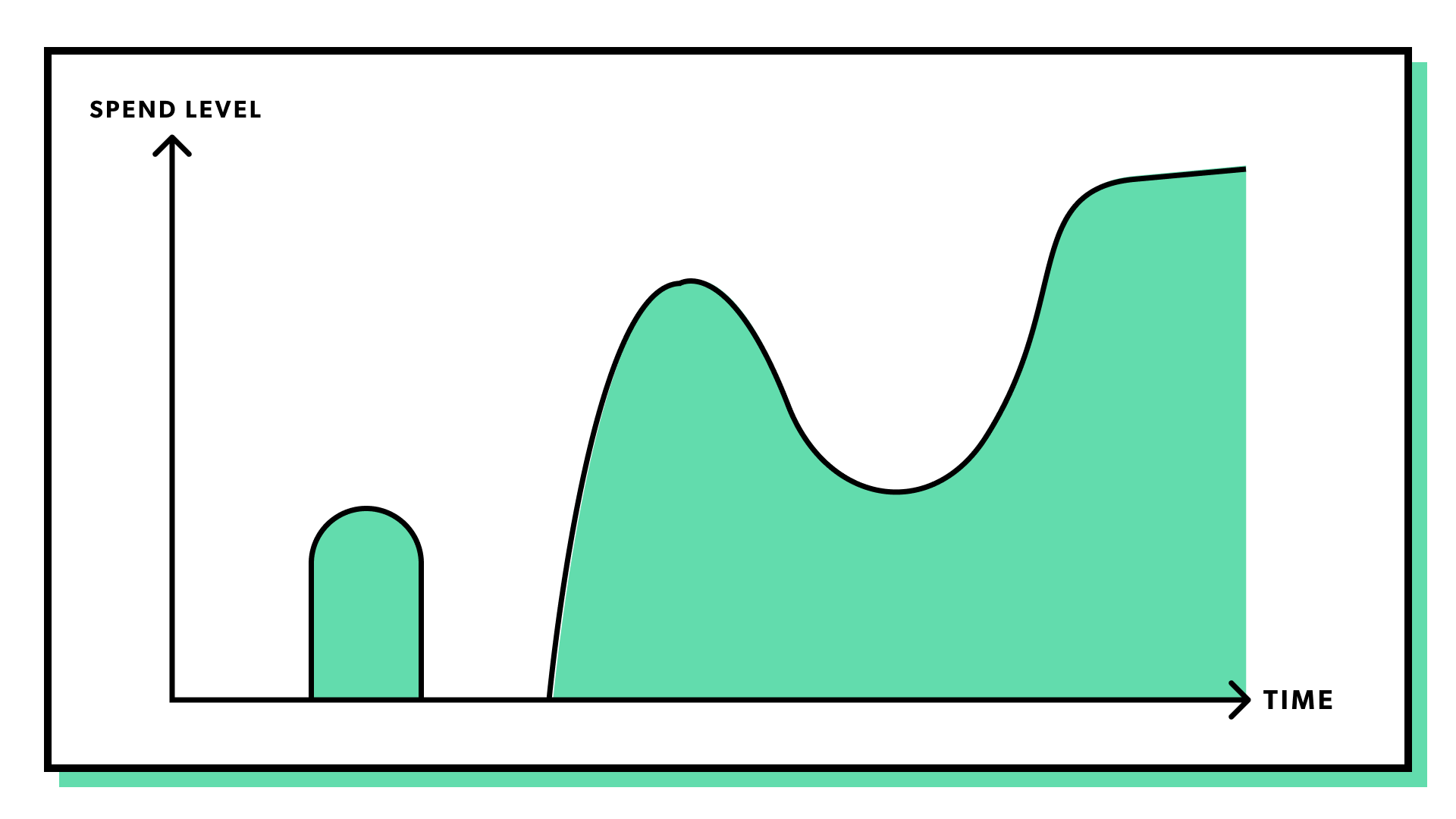
However, the path isn’t always smooth. We’ve seen companies, especially those new to brand advertising, go through what we call the “Oops, OK” pattern. Initial experimentation often meets disappointment due to inadequate planning or insufficient budget, halting the spend. Then, typically after a slowdown in growth rate, companies restart with a bigger budget. But the cycle can repeat, leading to a stop-and-start pattern before finding the right balance.
To avoid false starts, we recommend companies be prepared to invest a 7-figure budget for a high-impact brand campaign to see visible brand lift, and even more for late-stage companies.
Teams also need to be very disciplined ahead of time to agree on success metrics. It’s seductive to think once you have brand media in market, sales will follow immediately. The reality is that brand campaign works itself slowly into the psyche, and using performance marketing metrics to evaluate brand campaign can only lead to disappointment.
It’s important to create a media planning and forecasting model: map out the audiences you’re reaching, analyze the volume needed to reach statistical significance in the brand lift studies, and project out the lagging effect on conversions.
Companies also need to be realistic about how long it takes to plan the creatives, execute the media buy with partners (some offline channels need months-ahead reservation), and orchestrate the ad ops and measurement plans. You need at least 3 months to plan the campaign, and ideally 4-5 months considering internal approvals and external media inventory availabilities.
Performance Ad Spend Patterns
Pattern 1: Gradual Uphill Climb
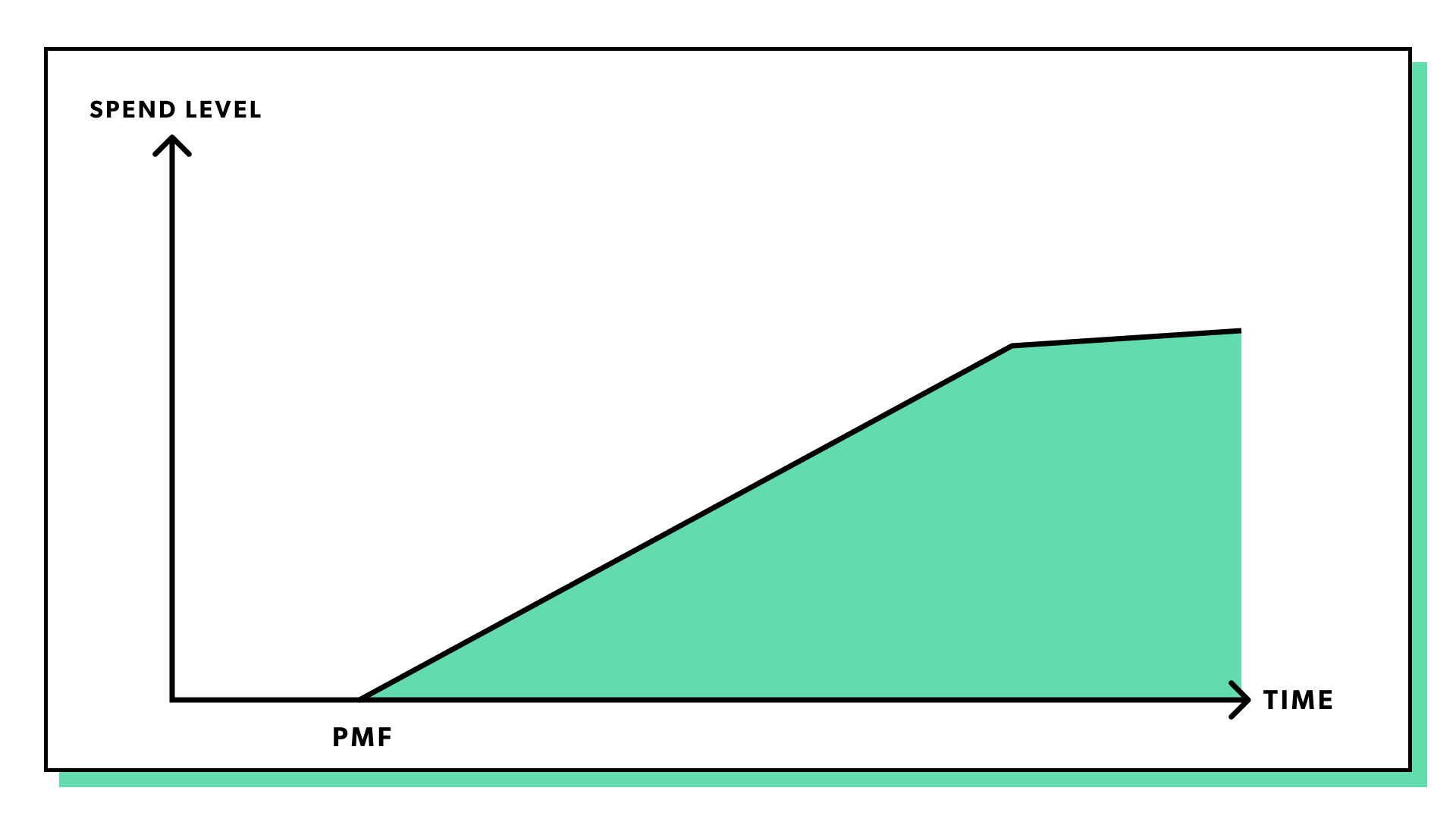
While it can be tempting to dive into quick-win ads early on, we recommend that companies don't initiate significant performance marketing until reaching product-market fit. After PMF is evident, starting small with search ads and gradually expanding to other formats, such as display and video ads, is the norm.
When working with earlier-stage founders just starting out with paid ads, we recommend starting with a $100 daily Google search ads budget, reaching 50 conversions so Google has enough data to start optimizing, and then gradually increasing the budget, making adjustments along the way.
You may notice that at some point, the efficiency of performance ads will decline after reaching a marginal ceiling — spending more no longer proportionally increases results due to reaching market saturation. At this juncture, it's time to innovate, possibly integrating brand advertising or exploring new markets.
However, depending on your audience, the ceiling should be pretty high, and there are a lot of creative, messaging, audience, targeting, and channel experiments you can run before hitting that ceiling.
Yes, many types of paid media are getting more and more expensive, but declaring “X channel doesn’t work” could be too soon in the majority of cases – the devil is in the execution details.
Instead, the right question to ask is “How do I make it work?” Performance marketers don’t give up on the first try, or the second try - don’t be discouraged if your campaigns are not delivering, rather, try another way.
Pattern 2: Exponential Growth
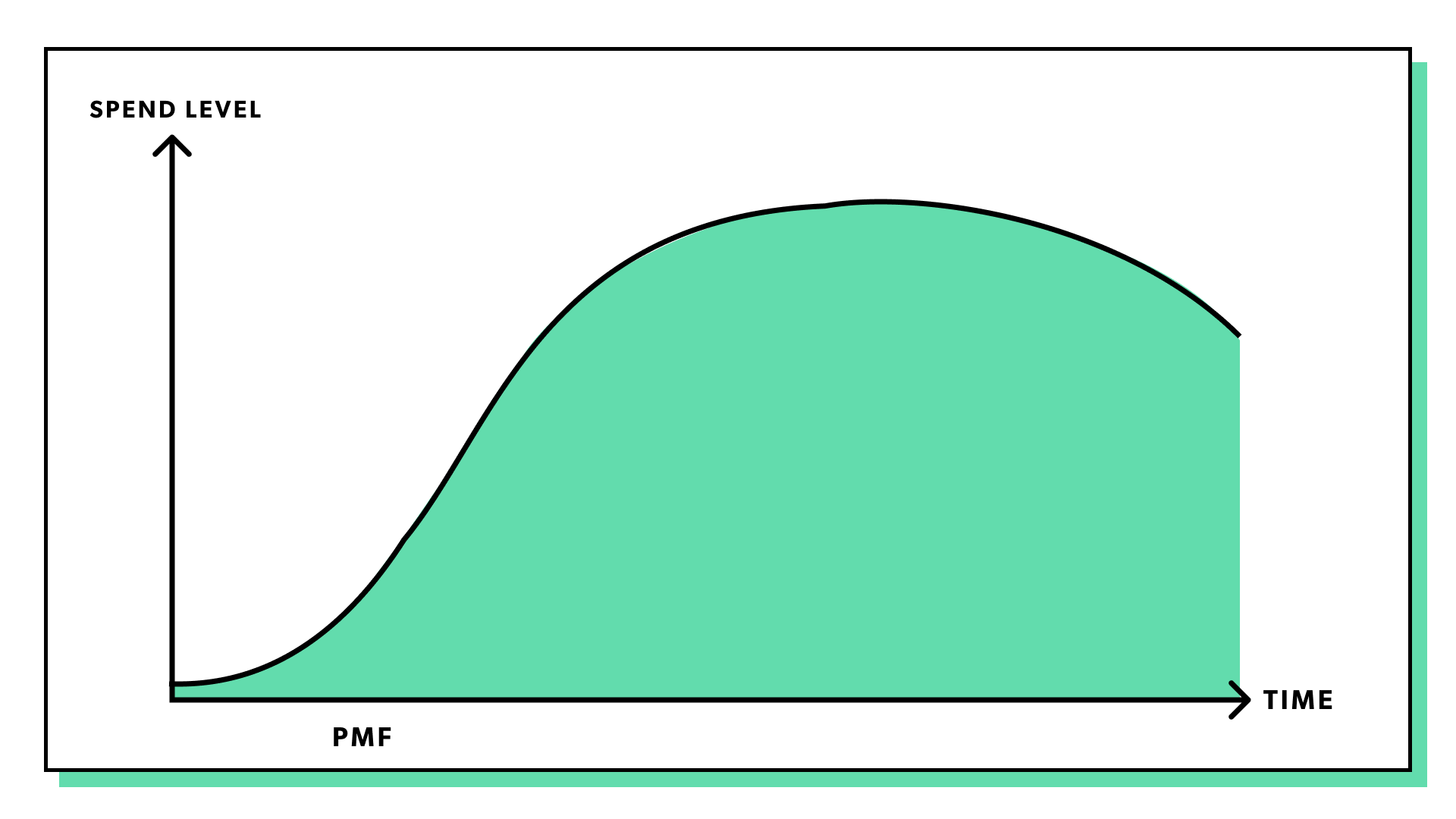
Venture-backed startups, before reaching PMF, may still use performance ads to test market interest, messaging resonance, or fight against the cold-start problem. For example, shall we call ourselves an “AI video editor” or an “AI video marketing platform”? Such a company might run some search ads and observe the search volume, click-through rate, and conversion rate to get some signal.
After reaching PMF or raising substantial funding in Series B, these startups frequently exhibit exponential growth in performance ad spending. It's not uncommon to see monthly spend skyrocketing from $10K to $100K in just a couple of months at companies we’ve worked with. Discipline around CAC to LTV ratio and payback period is vital here to ensure efficient conversions and quality user acquisition.
Mature companies may reduce performance spend after a while, sometimes, like Airbnb, they’d shift spending to brand ads to maintain top-of-mind awareness or further education and engagement. Other times, their other organic channels, such as SEO, partnerships, community, and category dominance can drive efficient conversions, reducing the need to keep increasing paid budget.
Combined Spend Pattern
For B2B, once brand advertising proves its value, startups often settle into a combined pattern of seasonal peaks for brand and consistent spending for performance.
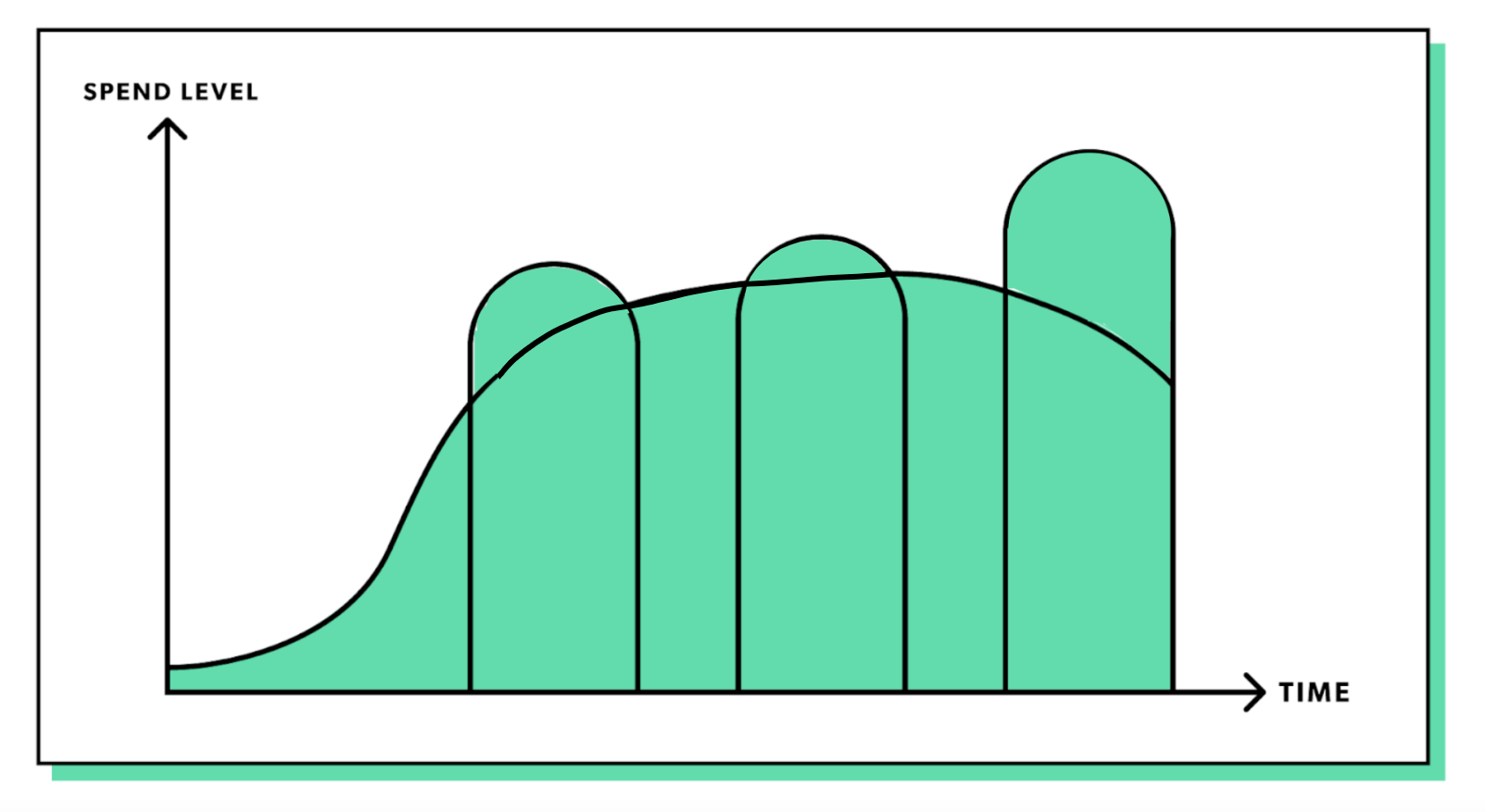
For B2C, this pattern could be shifting at a faster pace. For example, a DTC brand’s media schedule could include spending bursts for holidays like Mother’s Day and Father’s Day, or seasonal events like back to school and Black Friday (along with any new product launches).
How do you actually allocate budget in your next fiscal year planning?
As with the deciding factors for when, how to distribute your budget allocation is multifaceted. ‘Did the competition recently run a brand campaign? And in what markets for which audiences?’ ‘Did we recently launch a new product where we need to get users into it quickly?’ ‘What's happening in the economy – is it a quiet campaign year where my brand advertising budget for pricey channels like OTT can go further?’
Say you have under $1M yearly paid budget, put all of that into performance marketing, it will deliver the best immediate ROI — but that well will dry up. If you have $5M yearly paid budget (and you know you need brand media, based on the framework we shared earlier), or if there’s strong signal from the market that you’re not even in the prospect’s consideration set, or your growth rate is slowing down, start your planning with $1.5M for brand, $3.5M for performance, and adjust based on your forecast model.
HOW TO MEASURE: TRACKING IMPACT THE RIGHT WAY
The most critical part of any marketing program – performance or brand – is to prove it out so you can see what’s working, what’s not, why, and make adjustments as your year goes on. In a holistic campaign, the measurement is even more paramount and complex. You’ve spent the money — how do you measure what you’re getting back?
KPIs for Brand Ads: Reach, brand awareness, and brand affinity are most often used to measure brand awareness. You can find these through:
- Brand tracker surveys: done internally with a Research & Insights team or marketing analyst, or outsourced to an agency like Kantar or YouGov
- Google Search Console: Branded search impressions
- Channel partners: YouTube video views, publisher ad impressions, etc.
Remember, brand advertising serves a different purpose than performance advertising, and that should be reflected in how you measure success. Short-sighted calculations like expecting brand ad spend to immediately bring conversions can misrepresent the value of brand advertising.
Instead, observe organic traffic increase, conversion rate lift, acceleration of the sales pipeline, etc., over an extended period. Understanding the customer journey and being patient with brand advertising’s long-term effects is key.
KPIs for Performance Ads: Conversions, Payback window and LTV:CAC ratio are important to measure efficiency.
One mistake performance teams can make is to focus only on top-of-funnel metrics like traffic, MQLs, or signups, and overlook quality and down-funnel metrics such as pipeline conversion, activation rate, or repeat purchases — increasing one may negatively impact the other.
For example, in one experiment, we reduced the number of questions on the demo request form, only asking for emails. The number of demo requests jumped, but conversion to qualified opportunities decreased. At the end of the day, pipeline didn’t increase as a result. In addition, the sales team had to spend more time sifting through leads. So teams should measure both top and down funnel metrics, as well as non-media costs such as overhead and time to conversion.
WRAPPING UP: THINKING DIFFERENTLY ABOUT BRAND AND PERFORMANCE
We’ve covered the foundation of how to evaluate and structure your performance and brand media program – but we’d be remiss not to take the opportunity to push early-stage companies to think differently about brand marketing. Brand marketing should be unique to you, your company values from the founders and leadership team, that sets you apart.
Look at brand marketing as the single thread that sets perceptions and expectations for what the product represents and will do for them – that is your brand promise.
The in-product experience is more influential to your brand than any campaign will ever be – so product and brand should be holding hands to truly have your brand marketing work for you.
While the distinctions between brand and performance marketing are manifold, their true potential is unlocked when they are interwoven, working in harmony. It's high time we envision them not as separate entities, but as instruments in the same orchestra. In this ever-evolving marketing landscape, it's not just about the brand or the performance — it's about the symphony they create together.
